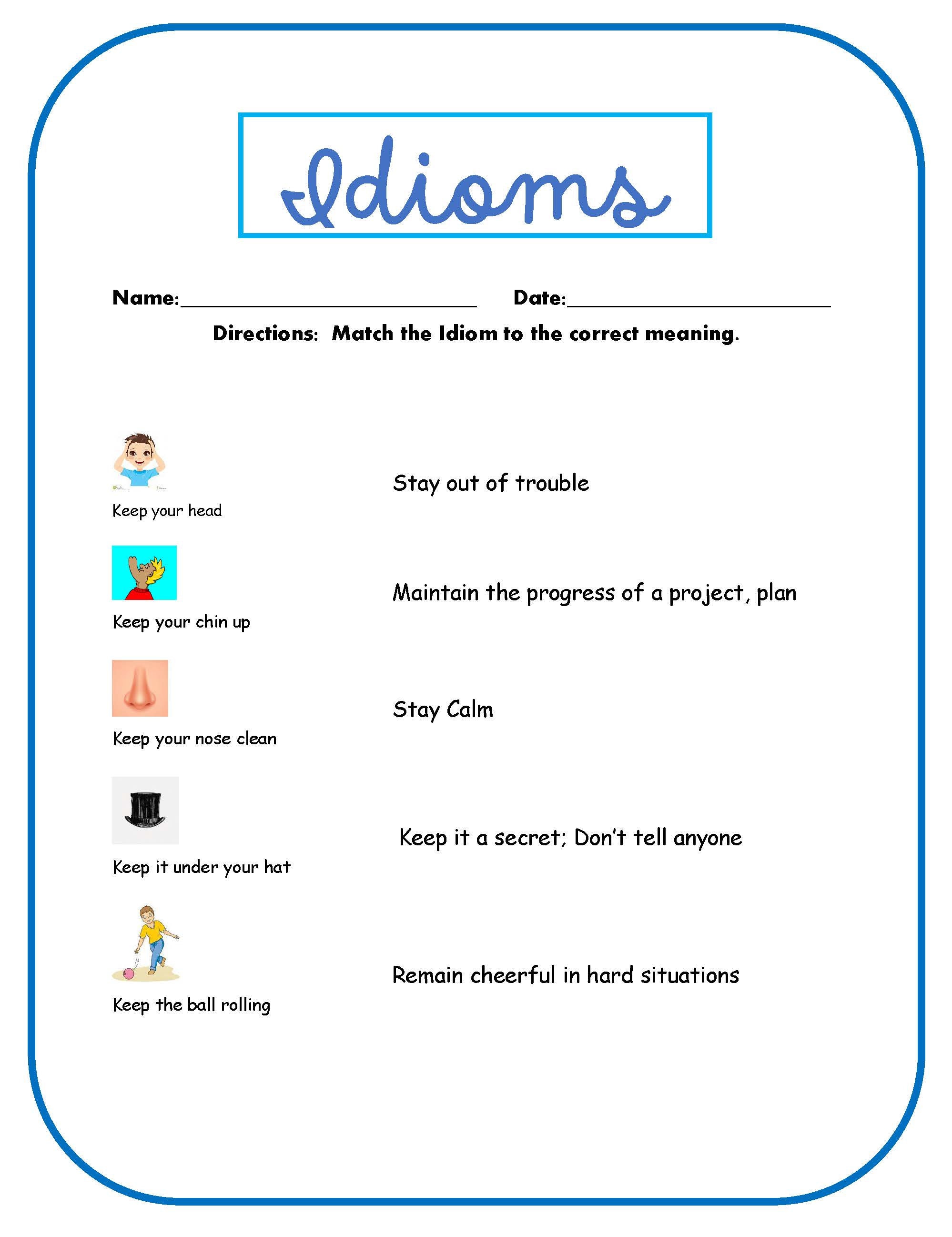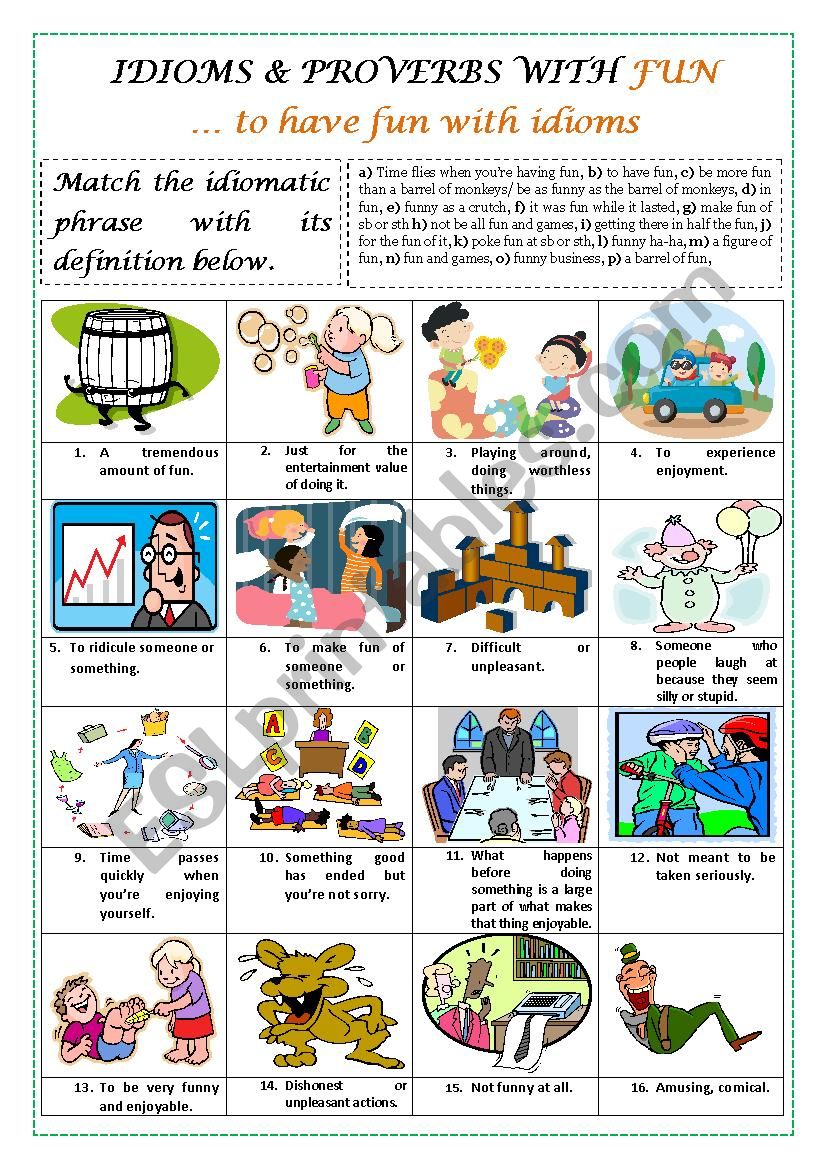
Unlocking Linguistic Nuances: The Power of Idioms Worksheets in Language Learning
Language is a tapestry woven with threads of grammar, vocabulary, and structure, but its true richness often lies in the vibrant patterns of idiomatic expressions. Idioms, phrases whose meanings cannot be deduced from the literal meanings of their individual words, are the colorful brushstrokes that give language its character, depth, and natural flow. For language learners, both native and non-native speakers, mastering idioms is not just about expanding vocabulary; it’s about gaining cultural insight, achieving fluency, and truly sounding like a native speaker. This is where idioms worksheets emerge as an indispensable tool, providing structured, engaging, and effective pathways to idiomatic mastery.
The Indispensable Role of Idioms in Language Acquisition
Imagine trying to understand a conversation where someone says they "spilled the beans," "bit the bullet," or are "feeling under the weather," without knowing what these phrases actually mean. The literal interpretation would lead to utter confusion. Idioms are ubiquitous in everyday conversation, literature, media, and professional communication. Their mastery signifies a higher level of linguistic proficiency and cultural understanding.

For English as a Second Language (ESL) or English as a Foreign Language (EFL) learners, idioms often present a significant hurdle. They defy logical analysis and require memorization within context. However, once understood, they unlock a deeper appreciation for the language’s nuances and allow learners to participate more authentically in discussions. For native speakers, particularly younger ones, idioms worksheets can enhance vocabulary, improve comprehension of complex texts, and refine their expressive abilities, moving beyond basic communication to more sophisticated articulation.

Why Idioms Worksheets Are Essential Learning Tools

In an age of digital learning, the humble worksheet might seem old-fashioned, but its pedagogical value remains unparalleled, especially for a tricky subject like idioms. Idioms worksheets offer a structured environment for practice, reinforcement, and assessment. Here’s why they are so effective:

- Contextual Learning: Idioms are best learned within a context. Worksheets can present idioms in sentences, short dialogues, or mini-stories, helping learners infer meaning before it’s explicitly given. This active engagement aids retention far more than rote memorization.
- Repetitive Practice: Mastery comes through repetition. Worksheets provide ample opportunities to encounter and use the same idioms multiple times in varied exercises, solidifying understanding and recall.
- Active Engagement: Unlike passive listening or reading, worksheets demand active participation. Learners must analyze, match, complete, or create, which deepens their cognitive processing of the material.
- Visual and Kinesthetic Reinforcement: Many worksheets incorporate visual elements (pictures, diagrams) or require writing, appealing to different learning styles and enhancing memory.
- Targeted Learning: Worksheets can be designed to focus on specific categories of idioms (e.g., idioms about feelings, time, animals, business) or those relevant to a particular theme, making the learning process more manageable and relevant.
- Self-Paced Learning: Learners can work through worksheets at their own pace, reviewing challenging items as needed, making them ideal for both classroom use and independent study.
- Assessment and Feedback: Worksheets provide a tangible way for both learners and educators to assess progress. Answer keys allow for immediate self-correction, fostering independent learning.



Types of Effective Idioms Worksheets

The versatility of idioms worksheets allows for a wide array of exercise types, each targeting different aspects of learning:
- Matching Exercises: These are fundamental, requiring learners to match an idiom with its definition or an appropriate picture. Simple and effective for initial recognition.
- Fill-in-the-Blank: Learners complete sentences using a given list of idioms, often requiring them to choose the idiom that best fits the context. This emphasizes contextual understanding.
- Sentence Creation: A more advanced task where learners are given an idiom and must use it correctly in their own original sentence. This promotes active application and creative thinking.
- Multiple Choice Questions: Presenting an idiom and asking learners to choose the correct meaning from several options, or vice-versa. Good for quick assessment.
- Story Completion/Dialogue Writing: Learners are given a story or dialogue prompt and must incorporate a set of idioms to complete it naturally. This pushes them towards more authentic language use.
- Picture-Based Idioms: Worksheets that use illustrations to depict the literal meaning of an idiom, then ask learners to explain its figurative meaning. Excellent for visual learners and for highlighting the often humorous discrepancy between literal and figurative.
- Contextual Reading Comprehension: Short passages or dialogues embedded with several idioms. Learners read the text and then answer questions about the idioms’ meanings as used in that specific context.
- "Find the Idiom" Activities: Learners read a text and identify idioms within it, then explain their meaning. This hones their ability to recognize idioms in real-world language.
- Crossword Puzzles/Word Searches: While less focused on meaning, these can be fun ways to reinforce idiom recognition and spelling, often with clues that hint at the idiom’s meaning.

Designing Engaging Idioms Worksheets: Best Practices
Creating effective idioms worksheets requires more than just listing idioms and definitions. Thoughtful design maximizes their learning potential:
- Clear Instructions: Ensure instructions are concise, unambiguous, and easy to follow, especially for lower-level learners.
- Appropriate Level: The complexity of idioms and exercises should match the learners’ proficiency level. Start with common, easier idioms and gradually introduce more challenging ones.
- Relevant Context: Always provide idioms within a meaningful context. Isolated idioms are harder to remember. Use scenarios that resonate with learners’ experiences.
- Variety of Activities: Mix and match different exercise types within a single worksheet or across a series to keep learners engaged and cater to diverse learning styles.
- Visual Appeal: Use clear fonts, ample white space, and, where appropriate, relevant images or simple graphics. An uncluttered, visually appealing worksheet is less intimidating and more inviting.
- Manageable Chunks: Don’t overload a single worksheet with too many new idioms. Focus on a manageable number (e.g., 5-10) per sheet to prevent overwhelm and allow for deeper processing.
- Answer Keys: Always provide clear answer keys. This empowers learners to self-assess, learn from their mistakes, and take ownership of their learning.
- Progression: Design a series of worksheets that gradually increase in difficulty, from recognition to production, and from common to less common idioms.
Integrating Idioms Worksheets into the Curriculum
Idioms worksheets are not meant to be standalone activities; they are most effective when integrated into a broader language curriculum.
- Pre-teaching: Before assigning a worksheet, introduce the idioms. Use real-life examples, tell a story, or even act them out. This sets the stage for contextual understanding.
- In-class Practice: Use worksheets for individual practice, pair work, or small group collaboration. Discuss answers as a class, encouraging learners to explain their reasoning.
- Follow-up Activities: After completing a worksheet, encourage learners to use the idioms in conversation, role-plays, or writing assignments. The goal is to move from recognition and understanding to active production.
- Review and Reinforcement: Periodically revisit previously learned idioms through quizzes, games, or by incorporating them into new reading or listening materials.
Tailoring Idioms Worksheets for Diverse Learners
The beauty of idioms worksheets lies in their adaptability to various age groups and proficiency levels:
- For Young Learners: Focus on highly visual worksheets with simple, common idioms often related to animals, colors, or everyday actions. Use matching games, drawing activities, and fill-in-the-blanks with word banks. Keep it fun and interactive.
- For Teenagers: Introduce idioms relevant to social situations, pop culture, and academic life. Dialogue completion, short story writing, and debates using idioms can be highly engaging.
- For Adult ESL/EFL Learners: Tailor idioms to professional contexts, travel, or current events. Encourage discussion on cultural nuances associated with idioms. More complex reading passages and argumentative writing tasks incorporating idioms are suitable.
- For Native Speakers (Vocabulary Expansion): Worksheets can focus on more sophisticated or less common idioms, exploring their historical origins, and encouraging their use in formal writing and public speaking.
Overcoming Challenges with Idioms Worksheets
While highly effective, learners might still face challenges. Worksheets can help address these:
- Literal Interpretation: Learners often struggle to move beyond the literal meaning. Worksheets with "literal vs. figurative" sections or picture-based activities can highlight this distinction.
- Memorization vs. Understanding: Rote memorization is rarely effective for idioms. Worksheets that emphasize context and application (sentence creation, story writing) encourage deeper understanding.
- Overwhelm: The sheer number of idioms can be daunting. Breaking them down into thematic sets on separate worksheets makes the task less intimidating.
- Lack of Practice: Learners might understand idioms but hesitate to use them. Worksheets that require active production, followed by opportunities for oral practice, build confidence.
The Future of Learning: Digital Idioms Worksheets
While print worksheets remain valuable, the digital age has opened new avenues for creating and distributing idioms worksheets. Online platforms offer interactive exercises, instant feedback, audio pronunciations, and even adaptive learning paths. Digital worksheets can incorporate multimedia elements, making the learning experience even richer and more dynamic. This blend of traditional and modern approaches ensures that idioms continue to be a fascinating and conquerable aspect of language learning.
Conclusion
Idioms are the soul of a language, offering insights into its history, culture, and unique way of seeing the world. Mastering them is a significant step towards achieving true fluency and linguistic artistry. Idioms worksheets, in their myriad forms, provide the structured practice, contextual learning, and engaging activities necessary to demystify these often perplexing phrases. From basic matching to complex creative writing, these powerful tools empower learners of all ages and levels to confidently navigate the rich, idiomatic landscape of English, turning what once seemed like an insurmountable challenge into a rewarding journey of discovery. By consistently integrating well-designed idioms worksheets into language instruction, educators can equip learners with the linguistic confidence to not just speak English, but to truly "speak like a native."
